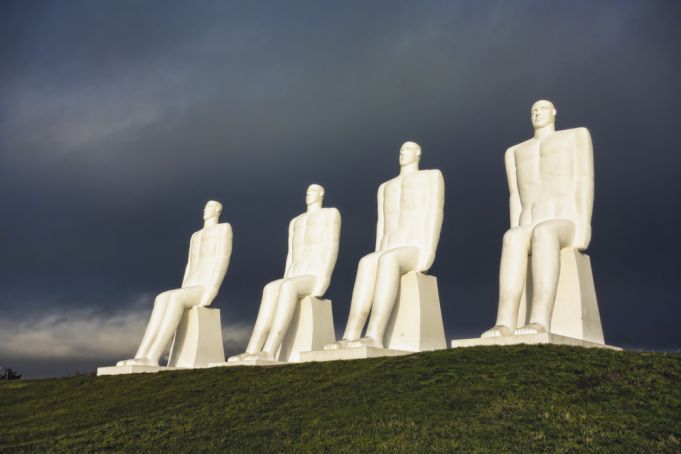Man Meets the Sea: The giant statues of Esbjerg
The budding, and perhaps most underdeveloped, town of Denmark is Esbjerg, made famous for the monument called Man Meets the Sea.
Esbjerg - the Youngest City in Denmark
The city of Esbjerg is the youngest city of its size in Denmark. In fact, it was founded not even a century and a half ago when a port was created to export agricultural products grown in the surrounding countryside. Subsequently, there was a literal explosion in the fishing industry which enriched the city.
Esbjerg is also known as a large producer of energy. Its wealth is due to the discovery of oil fields in the North Sea, and the construction of the largest wind farm in the world.
The city has grown quickly and provides for its citizens the typical services typical you would expect from a metropolis. There is wealth, but its rapid growth and relatively raw landscape mean historical attractions, that are the base of appealing to tourists in Denamrk, have not been developed.
Where is Esbjerg?
Esbjerg is a small town located on the Jutland peninsula (the westernmost of those that make up Denmark). More precisely, it is located in the southern region of this peninsula, on the west coast, overlooking the North Sea.
It is almost two hours away from the capital of this region, Aarhus, but just twelve minutes by ferry from the island of Fanø, a nice attraction for tourists looking for ancient fishing villages and beautiful beaches during the summer.
On the opposite side of the North Sea is England, which used to be connected to this city via a ferry that was discontinued in 2014.
Man Meets the Sea - The Statues

The reason to put Esbjerg on your itinerary when visiting Denmark, perhaps on the way to the nearby island of Fanø, is to see the large statues that characterize the beach on the North Sea titled Man Meets the Sea, alongside the port and industrial area.
Man Meets the Sea is an installation by Danish sculptor Svend Wiig Hansen, erected to mark the 100th anniversary of Esbjerg's founding as an independent municipality in 1994. The ceremony in which these statues were unveiled to the public took place on October 28, 1995. The statues are freely accessible at any time of day or night.
The Port of Esbjerg
From the large statues that make up the Man Meets the Sea installation, you can see the port of Esbjerg, looking at the sea to the left. This is Denmark's largest port on the North Sea, as well as one of the largest freight hubs in all of Northern Europe.
The port of Esbjerg is practically the only one that serves Denmark's oil and gas field extraction and processing industry, as well as the largest port in the world from which wind turbines for green energy production pass.
Originally up to six hundred fishing barges could be seen along the port, while today only a couple of them are still in use for shrimp fishing. Obviously, it is not possible to get too close to the harbor area, but in Dogger Quay, a large sandbank in the North Sea, you are quite close to the oil processing machines, as well as to a point where amateur fishing is allowed even without a license.
The port of Esbjerg is foremost the embarkment point for going to visit the small island of Fanø, just twelve minutes by ferry, where you can discover can unspoiled island of fishermen with two well- maintained historic villages and the most beautiful beaches in this part of Denmark.
Man ph: Marc Lechanteur / Shutterstock.com
General Info
View on Map
Man Meets the Sea: The giant statues of Esbjerg
Esbjerg, Denmark








